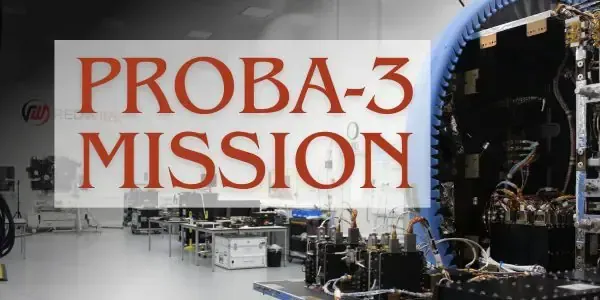Table of contents
UPSC Relevance
- GS Paper 3 (Science & Technology):
- Space technology advancements, international collaborations, and their applications for scientific research.
- GS Paper 2 (International Relations):
- India’s growing role in global space partnerships and soft power diplomacy through ISRO’s achievements.
- GS Paper 1 (Geography):
- Understanding space weather phenomena and their impacts on Earth.
News Article

Proba-3 Mission
- Launch Details:
- Proba-3, a European Space Agency (ESA) solar mission, will be launched by ISRO's PSLV rocket on December 4 from Sriharikota.
- The mission is part of ESA's Proba (Project for Onboard Autonomy) series. Previous missions include Proba-1 (2001) and Proba-2 (2009), also launched by ISRO.

- Unique Aspect:
- Proba-3 will pioneer "precision formation flying," where two satellites will fly in tandem, maintaining a fixed configuration in space.
- Estimated cost: €200 million.
- Mission life: Two years.
- Orbit: Highly elliptical (600 x 60,530 km) with a period of 19.7 hours.
Mission Objectives
Core Study:
- Study the solar corona, the Sun’s outermost and hottest layer, crucial for understanding space weather.
- Solar phenomena like solar storms and solar winds originate from the corona and can affect satellite communications, navigation, and power grids on Earth.
Scientific Instruments:
- ASPIICS (Coronagraph):
- Observes the Sun’s inner and outer corona, typically visible during solar eclipses.
- Equipped with a 1.4-meter occulting disk to block direct sunlight and reveal corona details.

- DARA (Digital Absolute Radiometer):
- Measures the Sun’s total energy output (total solar irradiance).
- 3DEES (3D Energetic Electron Spectrometer):
- Measures electron fluxes in Earth's radiation belts, aiding space weather studies.
Uniqueness of Proba-3
- Artificial Solar Eclipse:
- Two satellites — Occulter Spacecraft (200 kg) and Coronagraph Spacecraft (340 kg) — mimic a natural solar eclipse.
- The Occulter creates a shadow for the Coronagraph, enabling extended corona observations.
- Observations equivalent to 50 solar eclipses annually, with six hours of continuous corona visibility.

- Precision Formation:
- Satellites maintain a precise separation of 150 meters in Earth’s orbit.
- Autonomous formation flight ensures stability, allowing the Occulter to block the Sun’s bright light and facilitate corona imaging.
Significance for India
- Showcasing ISRO’s Capabilities:
- Demonstrates India's reliability in cost-effective and precise satellite launches.
- Highlights ISRO’s growing reputation as a global space partner.

- Scientific Collaboration:
- Indian solar physicists have contributed to conceptualizing the mission's scientific goals alongside Belgian researchers.
- Potential exclusive access to Proba-3 data for Indian researchers.
- Synergy with Aditya-L1:
- India’s Aditya-L1 mission (2023) aims to study the Sun’s corona and other solar phenomena.
- Collaborative research using Proba-3 and Aditya-L1 data could advance scientific understanding of the Sun and space weather.
Expected Benefits
- Scientific Advancements:
- Detailed study of the Sun’s corona will enhance understanding of space weather phenomena and their impact on Earth.
- New insights into solar storms and winds will contribute to the protection of satellite and communication infrastructure.
- Technological Innovations:
- First-ever precision formation flying will showcase advancements in satellite coordination and control.
- International Collaboration:
- Strengthens India’s partnership with ESA and provides an opportunity for Indian scientists to collaborate on cutting-edge solar research.
- Boost to Domestic Space Science:
- Access to advanced data will help Indian researchers develop expertise in solar physics and space weather modeling.

List of Solar Probes and Missions launched by space agencies worldwide
1. NASA (United States)
- Pioneer Missions (1958–1978)
- Early missions (Pioneer 5, 6, 7, 8, 9) to study solar winds and the interplanetary magnetic field.
- Helios Missions (1974 & 1976)
- Joint NASA-German Aerospace Center (DLR) missions.
- Focus: Studied the solar wind and magnetic field near the Sun.
- Ulysses (1990)
- Joint NASA-ESA mission.
- Objective: Study the Sun’s polar regions and solar wind.
- SOHO (Solar and Heliospheric Observatory, 1995)
- Joint NASA-ESA mission.
- Goal: Study the Sun’s interior, corona, and solar winds.
- STEREO (Solar Terrestrial Relations Observatory, 2006)
- Two spacecraft providing a 3D view of the Sun.
- Focus: Solar eruptions and coronal mass ejections (CMEs).
- Parker Solar Probe (2018)
- Closest spacecraft to the Sun (approx. 6.9 million km from the surface).
- Goal: Study the corona, solar wind, and solar magnetic fields.
- Launch Date: August 12, 2018
- Key Features:
- The closest spacecraft to the Sun, with perihelion distances of about 6.9 million km from the Sun’s surface.
- Studying the Sun’s corona, solar wind, and magnetic fields.
- First spacecraft to directly touch the solar corona.
- Significance: Provides unprecedented insights into solar activity, helping to predict space weather more effectively.



- IMAP (Interstellar Mapping and Acceleration Probe, 2025 - Planned)
- Designed to study the boundary of the heliosphere and the Sun’s influence on interstellar space.
2. European Space Agency (ESA)
- SOHO (1995): Collaboration with NASA (detailed above).
- Solar Orbiter (2020)
- Goal: Study the Sun’s poles and inner heliosphere.
- Features: Provides high-resolution imaging of the Sun.
- Launch Date: February 10, 2020
- Key Features:Studying the Sun’s poles and inner heliosphere.Carries high-resolution imaging instruments to observe solar wind, magnetic fields, and solar flares.Orbit allows close encounters with the Sun (as close as 42 million km).
- Significance: Offers detailed data on the Sun’s magnetic field and solar wind dynamics.



- Proba-3 (2024 - Planned) - Discussed in the news above
- First mission to achieve "precision formation flying."
- Focus: Study the solar corona and space weather.
3. Indian Space Research Organisation (ISRO, India)
Aditya-L1 (2023)
- First Indian mission to study the Sun.
- Objective: Observe the solar corona, chromosphere, and photosphere.
- Payload: Includes coronagraph and instruments to measure solar wind.
- Launch Date: September 2, 2023
- Key Features:India’s first solar mission designed to study the Sun’s corona, photosphere, chromosphere, and solar wind.Positioned at the Lagrange Point 1 (L1), about 1.5 million km from Earth.Equipped with instruments like the Visible Emission Line Coronagraph (VELC) and Solar Ultraviolet Imaging Telescope (SUIT).
- Significance: Aims to improve our understanding of solar activity and its effects on the Earth’s magnetosphere.


4. Russian Space Agency (Roscosmos)
Interhelioprobe (Planned for late 2020s)
- Goal: Study solar magnetic activity, solar wind, and the heliosphere.
5. Japanese Space Agency (JAXA)
Hinode (Solar-B, 2006)
- Collaboration with NASA.
- Focus: Study the Sun’s magnetic fields, corona, and solar wind.
6. Chinese Space Agency (CNSA)
- ASO-S (Advanced Space-based Solar Observatory, 2022)
- China's first dedicated solar observatory.
- Focus: Study solar magnetic fields, solar flares, and coronal mass ejections.
- Launch Date: October 9, 2022
- Key Features:
- First dedicated Chinese solar observatory.
- Studies solar flares, coronal mass ejections (CMEs), and magnetic fields.
- Equipped with three key instruments: Lyman-alpha Solar Telescope, Full-disk Vector Magnetograph, and the Hard X-ray Imager.
- Significance: Helps monitor space weather and its impact on Earth.

- CLASP Missions (Planned)
- Collaborating with international agencies for advanced solar studies.
7. Korean Astronomy and Space Science Institute (KASI)
KASISAT 1 (Planned for 2020s)
- Goal: Dedicated to studying the Sun and its influence on the Earth's magnetosphere.
8. Heliospheric Missions (Collaborations)
- BepiColombo (ESA-JAXA, 2018)
- Primarily for Mercury exploration but carries instruments to study the solar wind.
- Voyager Missions (NASA, 1977)
- Although interstellar probes, they study the boundary of the Sun's heliosphere.

